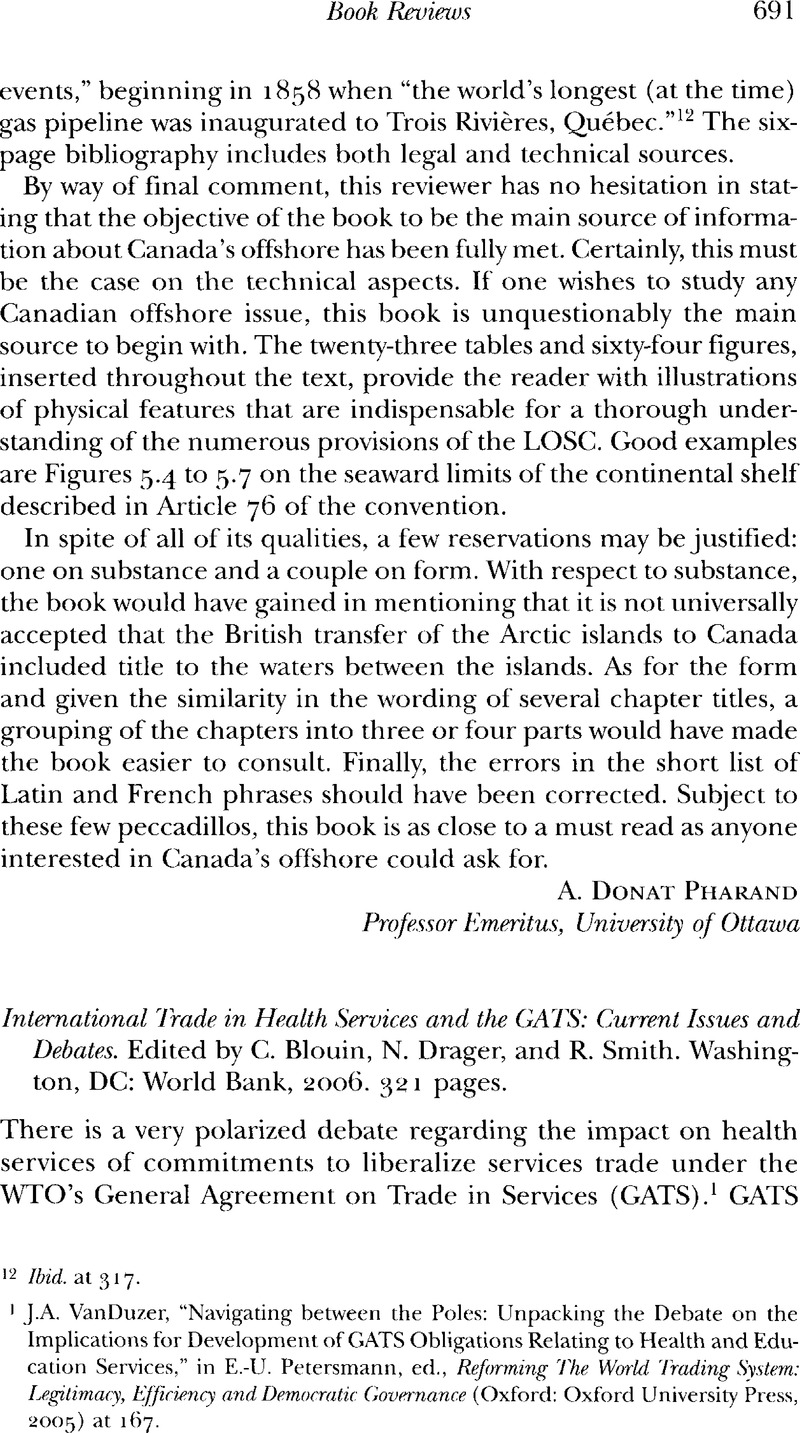No CrossRef data available.
Article contents
International Trade in Health Services and the GATS: Current Issues and Debates. Edited by C. Blouin, R. Smith. Washington, DC: World Bank, 2006. 321 pages.
Published online by Cambridge University Press: 09 March 2016
Abstract

- Type
- Book Reviews / Recensions de livres
- Information
- Canadian Yearbook of International Law/Annuaire canadien de droit international , Volume 43 , 2006 , pp. 691 - 701
- Copyright
- Copyright © The Canadian Council on International Law / Conseil Canadien de Droit International, representing the Board of Editors, Canadian Yearbook of International Law / Comité de Rédaction, Annuaire Canadien de Droit International 2006
References
1 VanDuzer, J. A., “Navigating between the Poles: Unpacking the Debate on the Implications for Development of GATS Obligations Relating to Health and Education Services,” in Petersmann, E.-U., ed., Reforming The World Trading System: Legitimacy, Efficiency and Democratic Governance (Oxford: Oxford University Press, 2005) at 167.CrossRefGoogle Scholar
2 The GATS positive list approach allows World Trade Organization (WTO) members to decide whether to undertake the higher tier of commitments under the agreement, including guaranteeing national treatment and market access, for individual sectors by listing them in a national schedule of commitments. Members may also limit the extent of their commitments by limitations they write into their schedules.
3 For example, Adlung, R., “The GATS Negotiations: Implications for Health and Social Services” (2003) 38 Intereconomics 147.CrossRefGoogle Scholar
4 For example, Chanda, R., “Trade in Health Services” (2002) 80 Bulletin of the World Health Organization 158.Google ScholarPubMed
5 Mashayekhi, M., Julsaint, M., and Tuerk, E., “Strategic Considerations for Developing Countries: The Case of GATS and Health Services,” in Blouin, C., Drager, N., and Smith, R., eds., International Trade in Health Services and the GATS: Current Issues and Debates (Washington, DC: World Bank, 2006), 17.Google Scholar
6 There is a process under the General Agreement on Trade in Services (GATS) Article XXI that permits a country to withdraw a commitment subject to an obligation to give compensation to other WTO members who claim that their benefits under the agreement are affected.
7 Adlung, R. and Carzaniga, A., “Update on GATS Commitments and Negotiations,” in Blouin, , Drager, , and Smith, , supra note 5, 83.Google Scholar
8 Ibid, at 99. The costs and benefits are discussed in another chapter of the book discussed below: Blouin, C., “Economic Dimension and Impact Assessment of GATS to Promote and Protect Health,” in Blouin, , Drager, , and Smith, , supra note 5, 169.Google Scholar
9 Nielson, J., “Ten Steps to Consider Before Making Commitments in Health Services under the GATS,” in Blouin, , Drager, , and Smith, , supra note 5, 101.Google Scholar
10 Fidler, D., Drager, N., Correa, C., and Aginam, O., “Making Commitments in Health Services under the GATS: Legal Dimensions,” in Blouin, , Drager, , and Smith, , supra note 5, 141.Google Scholar
11 Mashayekhi, Julsaint, and Tuerk, supra note 5.
12 Ibid, at 156.
13 The authors cite the conclusion of a joint study by the WTO and the World Health Organization (WHO) that “the overall effect of GATS on trade in health services is negligible to date” (ibid, at 163).
14 Blouin, C., “Economic Dimension and Impact Assessment of GATS to Promote and Protect Health,” in Blouin, , Drager, , and Smith, , supra note 5, 169 Google Scholar; Blouin, C., Gobrecht, J., Lethbridge, J., Singh, D., Smith, R., and Warner, D., “Trade in Health Services under the Four Modes of Supply: Review of Current Trends and Policy Issues,” in Blouin, , Drager, , and Smith, , supra note 5, 203.Google Scholar
15 Smith, R., Blouin, C., and Drager, N., “Trade in Health Services and the GATS: What Next,” in Blouin, , Drager, , and Smith, , supra note 5, 235.Google Scholar
16 Chanda, R. and Smith, R., “Trade in Health Services and GATS: A Framework for Policymakers,” in Blouin, , Drager, , and Smith, , supra note 5, 245.Google Scholar
17 Ibid, at 243–44.
18 Indeed, the nature of the initiatives necessary to facilitate trade in health services will mean that other international organizations, such as the WHO and the UN Conference on Trade and Development (UNCTAD) are likely to play a more important role than the WTO. For example, the development of international quality assurance standards and procedures for assessment by the WHO and other bodies would encourage the international supply of health services in all modes.
19 Some work of this kind has already been done, for example, WHO and WTO, WTO Agreements and Public Health: A joint Study by the WHO and WTO Secretariats (Geneva: WTO, 2002).
20 For a broad-based discussion of international health governance, see Aginam, O., Global Health Governance: International Law and Public Health in a Divided World (Toronto: University of Toronto Press, 2005),CrossRefGoogle Scholar which is also reviewed in this volume.
21 This point is stressed by Aginam, ibid, at 90–108.


